THE TRUTH ABOUT AIR AMERICA
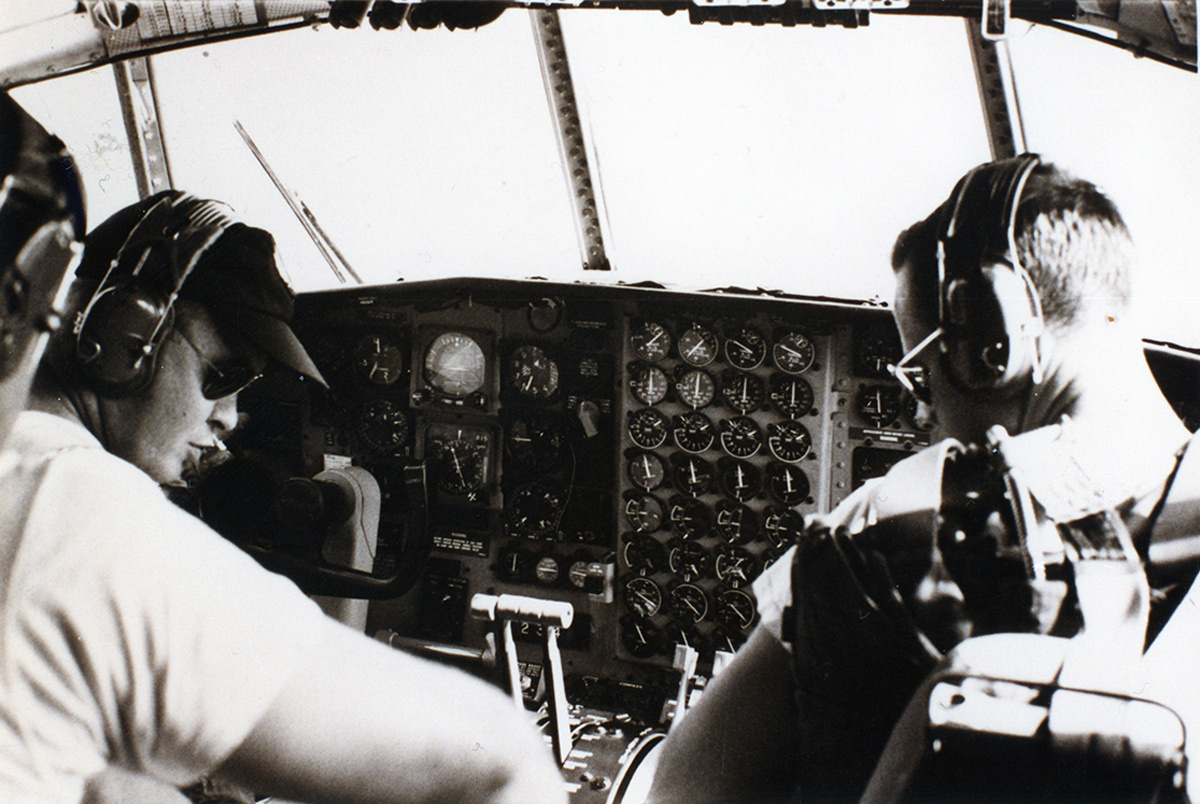
An April 1966 check ride in a Caribou with an Air America pilot in the right seat and his Lao counterpart in the left seat. (Photo courtesy Leigh Hotujec).
By Marc Yablonka
(This article was published in earlier form in Airways magazine in May 2000)
The rain was so incessant that if you closed your eyes long enough, it could have been Vietnam in 1968 in a heartbeat. Instead, it was Vo’s Restaurant in Oakland, California’s Chinatown, on a wintry Saturday afternoon in mid-April. Three former Air America pilots had come to set the record straight regarding the oft-maligned airline, once the wings for the Central Intelligence Agency, USAID, various generals, and political VIPs in Indochina.
Former pilots Vince Clarke, Marvin “Windy” Wingrove, both also World War II pilots, from Novato, CA—Wingrove flew P-38s in Africa and P-51s in Europe—place the blame in several corners for the reputation that Air America has received as a mysterious, secretive, drug-running band of misfit rogues.
First and foremost was the 1990 Carrolco Films release Air America, starring Mel Gibson and Robert Downey, Jr., which, unlike the very informative book by Christopher Robbins from which it was adapted, most Air America personnel term “entertainment at best.”
“The word was that Hollywood had it out for the CIA and, because we were an extension of them, we got the brunt of it,” said Richmond, CA Air America pilot Joe Mish, who was also in attendance at Vo’s that April day.
Willie Parker, of Fairfield-Suisan, CA, a former Air America crew chief, was not entertained by the film in the least. Parker, a former San Francisco International Airport-based aircraft systems maintenance controller, responsible for the airworthiness of United Airlines’ entire Worldwide fleet, put it succinctly,
“I would be satisfied if you took out everything the actors did in the film Air America. Absolutely nothing that happened in it was accurate.”
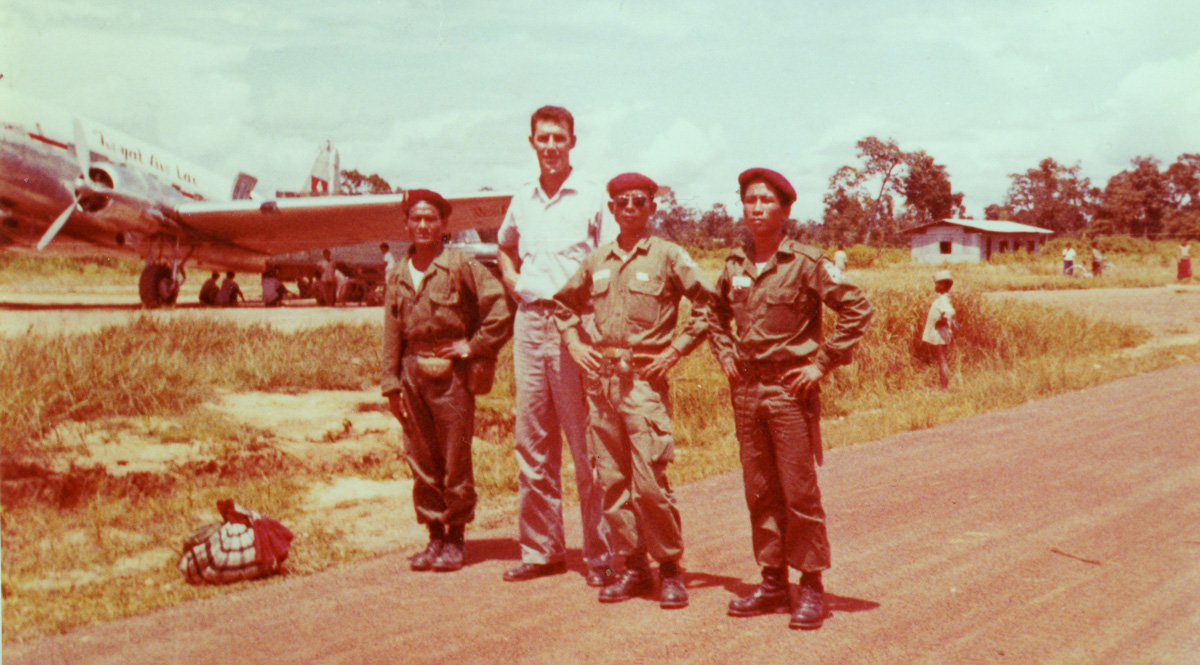
Air America pilot Ben Coleman (2nd from left) with three soldiers from the Royal Lao Army. (Photo courtesy Leigh Hotujec)
In fact, the film did a lot, the aviators feel, to further Air America’s negative image. It would have you believe that the company flew—for personal profit—the opium harvest of the Hmong people they often ferried in Laos from one battle to the next.
While some Air America pilots freely admit that opium conceivably could have been transported, they deny that anyone in Air America profited from it, as was portrayed in the film.
“I never knowingly transported any opium,” declared Ted Hellmers, former Air America helicopter pilot from his home in San Diego, from which he sells real estate since a helicopter crash terminated his flying career with the Los Angeles County Fire Department. While doing “stick time,” assisting firefighters on the ground, Hellmer’s chopper collided in mid-air with a US Forest Service helicopter. His co-pilot, a fellow Air America pilot from Vietnam, died in the crash. Although Hellmer’s desire was to keep flying, the FAA was sufficiently concerned about his future ability to fly helicopters that it pulled his ticket.
“I went looking for a new car and the salesman flat out insisted that I hauled dope all over Southeast Asia,” added Wingrove, who flew Bell 204 and 205 helicopters in Southeast Asia along with the fixed wing C-47/DC-3 “Gooney Bird” out of Saigon, Vientiane, Laos, and Udorn, Thailand, where Air America had its bases.
“We didn’t have the time nor the right to search anyone’s baggage when we transported them. Plus, there was a war going on,” explained Clarke, who flew the Twin Beech, Curtiss C-46, C-47, and DHC-4 Caribou for Air America after retiring from the Air Force.
Another factor that contributed to the mysterious misunderstandings flung Air America’s way lay in the Laos connection to the war. According to author Robbins, it was the secretive nature of the action in the landlocked country. The so-called secret war in Laos was, after all, a war that, on paper, never existed. Much of what Air America carried out there remained classified for years. Journalists were allowed no access to their missions. That was quite contrary, as documentaries have shown and correspondents have related, to Vietnam.
Mish stresses that Air America did far greater good than bad. “We were roguish, sure. But because of that—and the fact that we were civilians—we did things that regular pilots couldn’t or didn’t want to do.”
Mish does admit that Air America pilots often “pulled the devil’s tail.”
“I would fly down back roads in an empty Twin Beech and through Viet Cong road blocks. I’d look right into their faces as they would be swinging around to fire,” Mish said.
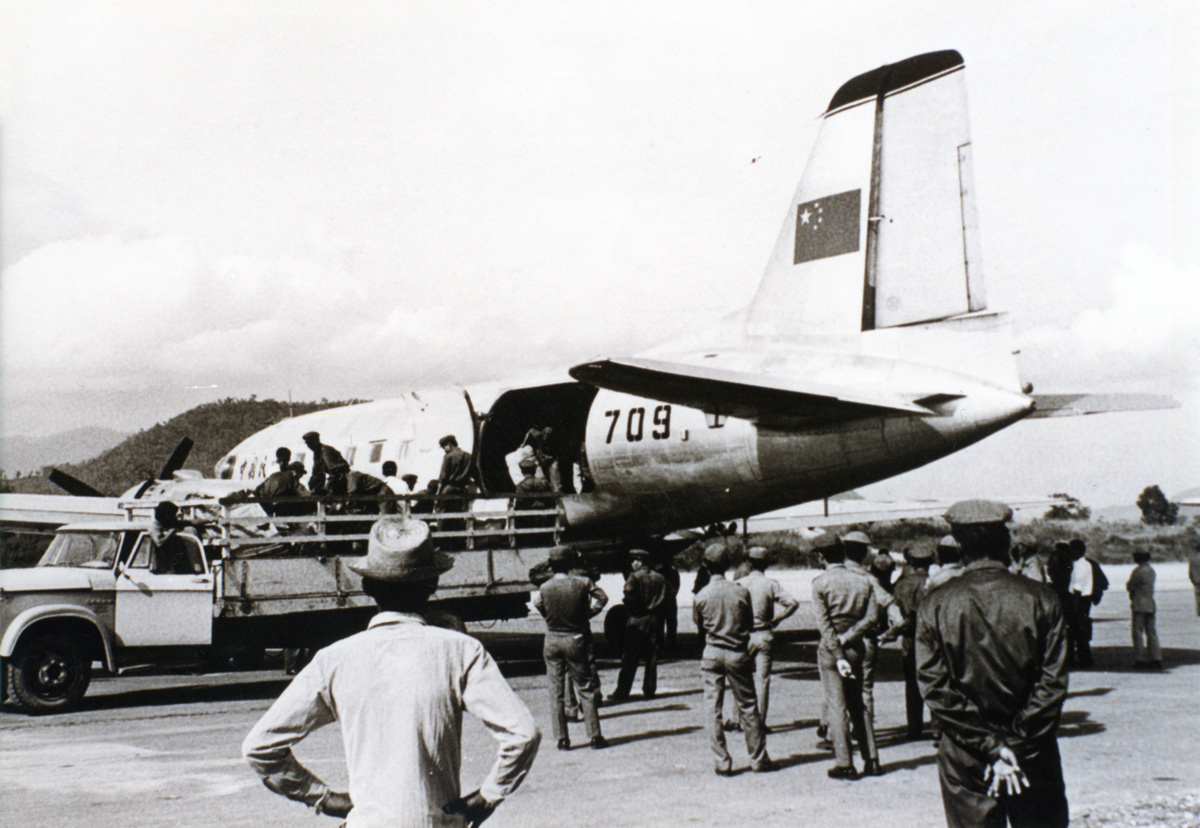
The beginning of the end: Arrival of Coalition troops (Communist Chinese and Pathet Lao) in Luang Prabang, Laos in 1974. The plane is a Russian-made Ilyushin with North Korean markings. (Photo by Leigh Hotujec)
He recalled one mission where his DC-3 served as a troop transport taking some badly needed replacements to a practically deserted outpost near the DMZ IN Quang Tri Province. His was a mission that not only did regular Air Force pilots not want—permission would not have been granted even if they had the desire. Mish flew to the outpost with no lights so as to avert a Viet Cong attack in a tropical downpour. Visibility, according to Mish, was near zero. But the replacements arrived safely at the outpost. A year or so later, an infamous siege involving the US Marines and a massive loss of life would take place in that outpost known as Khe Sanh.
“I used to say that I’d rather be lucky than smart,” Mish admitted. “You can be smart as hell and still be shot. Lucky will get you home.”
Added Clarke, “I always felt sorry for those Army guys. They had to be there. If we didn’t like it, we could have gone home any time we wanted.”
“Not that I cared so much for the CIA,” said Mish, “but they did do a lot of good things.” Some of those good things included having Air America fly US Embassy staff in aircraft, some of which was antiquated enough to have been right out of World War II.
They flew personnel, whether brass or (Royal Lao Army) troops from one strategic point in Vietnam, Laos, or Cambodia to another. They also transported staff from the United States Agency for International Development from one village to another. USAID took it upon itself to supply villages with everything, from food to matériel with which to repair settlements that had been blown asunder by the war. Their job, Indochina hands agree, was one of positive psychological warfare, designed, as President Lyndon Johnson declared, to “win hearts and minds.”
Perhaps in the case of USAID’s agenda, hearts and minds were won even if only temporarily and until the next firefight destroyed villagers’ homes again. Nonetheless, Air America, its pilots say, facilitated that good, whether it meant bringing in cement for buildings or rice for impoverished villagers to eat.
Air America did its fair share in rotating many of America’s soldiers around Indochina and, in some cases, enroute to the point from which they exited the war.
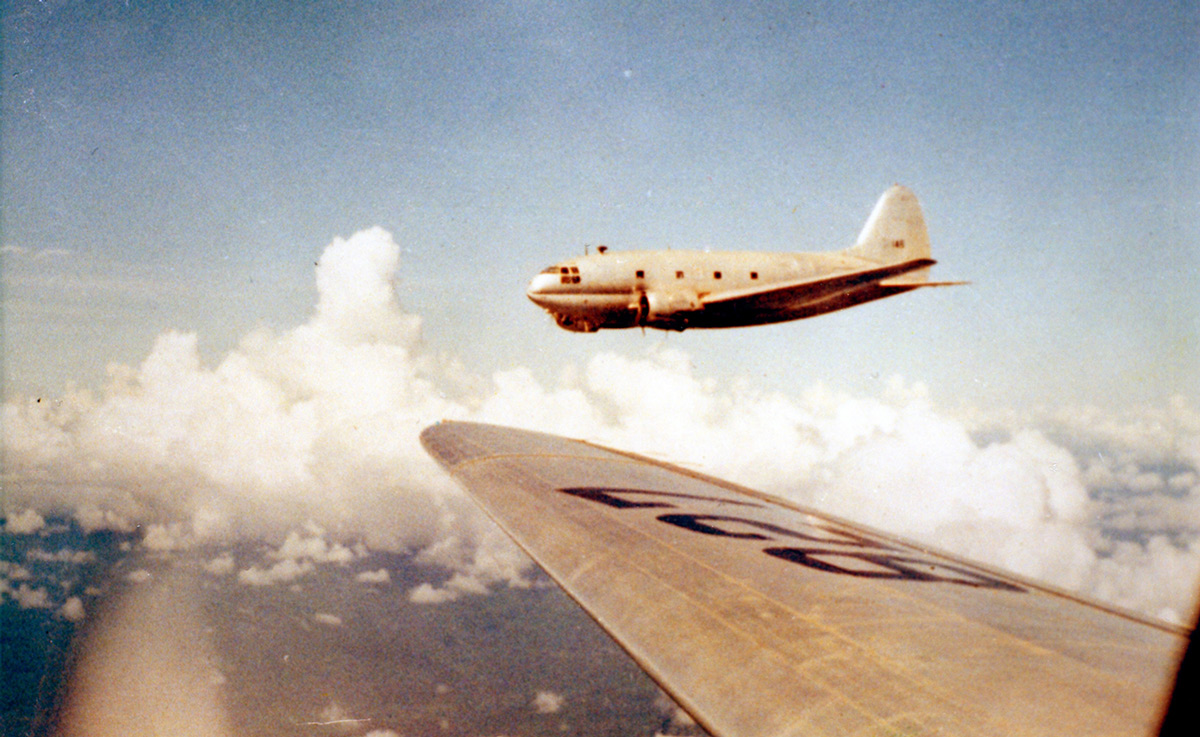
Unarmed, unmarked Air America C-46 en route to a supply drop in Laos in 1962. The photo was taken from an accompanying C-46. (Photo by Air America pilot Ben Coleman, courtesy his daughter, Leigh Hotujec)
“One time I was up at Dong Ha on the 17th Parallel and flew a bunch of Marines out,” Clarke recalled. “They were crying, saying `I’m going home.’ Man, they were so grateful.”
Along with the pain and suffering that war brings, there is always a degree of humor that exudes from the camaraderie developed in combat situations. Air America personnel were no different in that regard.
Wingrove, in Southeast Asia as early as 1959, proved that point many times over. While still a US Army pilot, he was tasked with flying around Laos in a well-used Piper Apache, volunteer Dr. Tom Dooley, who later wrote three books about the care he administered to the indigenous tribes of Southeast Asia during and after the French Indochina War. The airplane had been a gift of the citizenry of St. Louis, Missouri.
Wingrove, who joined Air America in 1965 and stayed with the outfit until 1974, a year before Laos fell to communist Pathet Lao forces, can move from thoughts of Dr. Dooley to laughter in no time.
“I flew pigs from one village to the next in Vietnam for one whole week,” he said, over a bottle of Ba Muoi Ba (33) Beer, the likes of which GIs drank in Vietnam. “Every damn takeoff, it never failed. By the time I would reach the end of the runway, they would be crapping everywhere. The next week I flew rice around. I’ll be damned if, right after that, rice didn’t start growing right there in the floorboards of the plane.”
But Wingrove’s treasure chest of stories does not stop with himself. “Anybody ever tell you about Shakey Calhoun?” he asked. “Shakey was a C-47 pilot. He smoked. In 1967 you weren’t anybody in Air America unless you had a gold Rolex. They were 950 bucks in those days. One day, while aloft, Shakey took off his watch to admire it. He located a cigarette, reached in his pocket and found a book of matches with only one match. He lit the cigarette and tossed his Rolex right out the window of his plane. The last time I saw him, he said he was going to bronze that match for stupidity’s sake and put it on his mantle.”
When the laughter dies down and another round of 33 is ordered, even Wingrove becomes serious. “There’s one thing you never got used to,” he said. “Being shot at.”
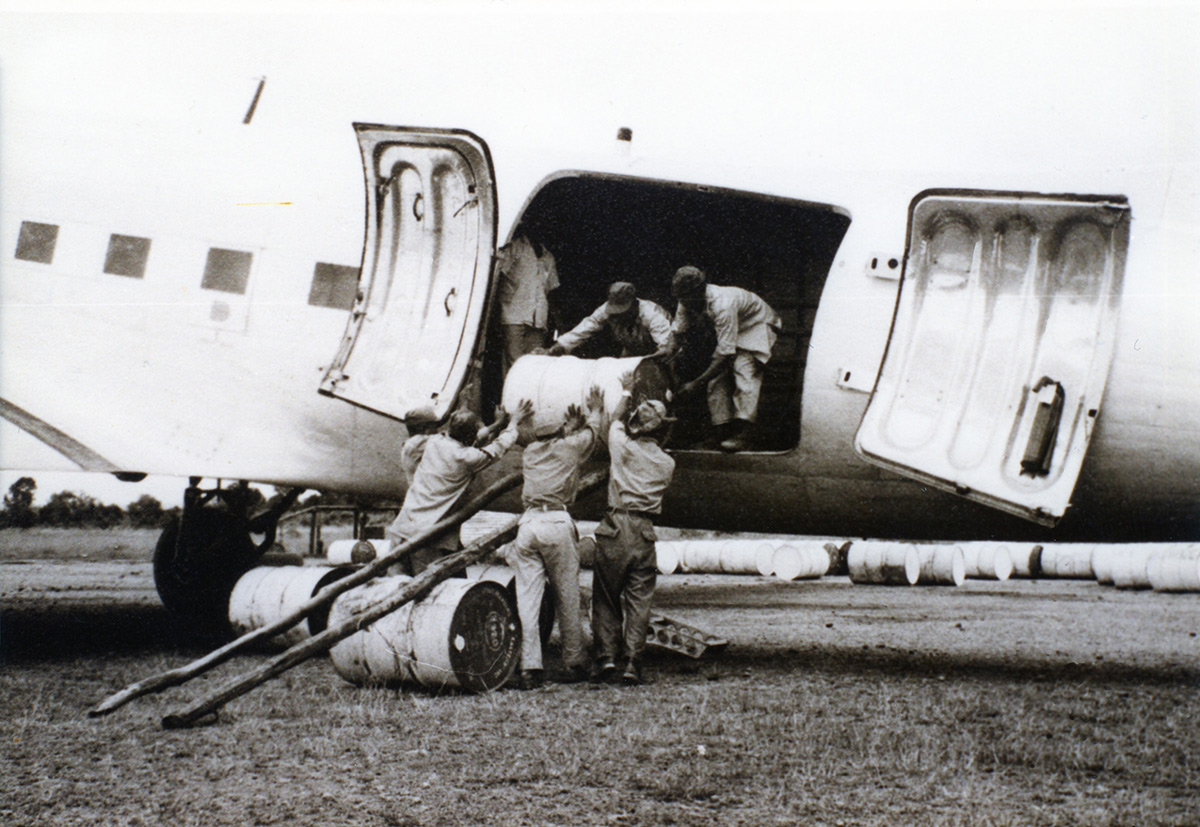
Troops loading gasoline drums at Pakse, Laos in 1962 for a journey to communist-infiltrated Saravane. Crews often ferried supplies like this, which made them literally flying bombs at the mercy of hostile fire, bad weather, or judgment. (Photo by Air America pilot Ben Coleman, courtesy his daughter, Leigh Hotujec)
Even though the general reputation that followed Air America pilots home after their tours ended was shrouded in mystery, at least for Vince Clarke and Joe Mish, nothing they did, to their knowledge, was termed classified. As Wingrove flew out of Laos, he cannot say the same.
Also, as with regular GIs, nothing they did put them in any different stead with their families when they returned.
“There was no connection,” related Mish. “We’d be sitting there watching the evening news and it was all Vietnam. I’d say, `That’s where I was last week. I might be acting a little squirrely now, `cause I’m going back.’ There was no recognition or acknowledgement. It was really strange. They just didn’t understand.”
What was it then, that enticed this remarkable crew of men to take the risks that they did in the name of Air America?
“As far as I was concerned, it was just as challenging as flying combat in the Air Force. When you cracked that 300-foot [100m] ceiling, when there was no real good ILS, or landing strip, when you took a load in on a real short runway, it felt pretty good. I told myself, `Man, I did something,’” explained Clarke. (Air America pilots were notorious for bringing their aircraft in safely, landing on runways so short or at such high altitudes that it defied logic that they could walk away from their airplanes).
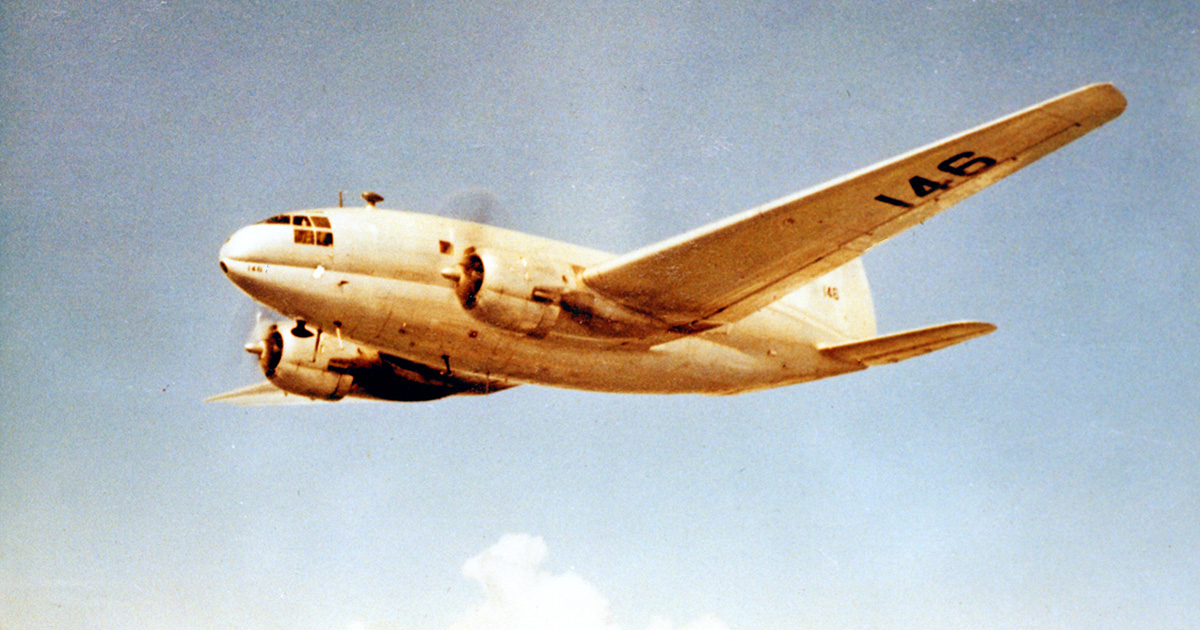
Air America C-46 en route back to Pakse, Laos in 1962 after an oil drum drop off in Saravane. (Photo by Air America pilot Ben Coleman, courtesy his daughter, Leigh Hotujec)
“One good thing about flying over there was that, if you lived through the first year or so, you grew very proficient because you flew hundreds of hours. I looked at my old logbook the other day. Twenty-one legs in the [Mekong] Delta in eleven hours,” Clarke mused.
“We were a one-man band, too,” added Mish. “Do the paperwork, run the passengers’ manifest, put oil in the engine. Can you imagine that? In a bleepin’ war zone?”
In all, Air America lost 242 personnel in Indochina. Yet you will find none of the names of those who gave their lives on the wall at the Vietnam Veterans Memorial in Washington, D.C. That was because they were employed as civilian pilots although most of them had previous military backgrounds.
“I don’t know if our KIAs not being recognized angers me or not,” said Clarke. “We were civilians who were paid well and knew what we were doing. Again, we could always go home whereas those [military] guys couldn’t.”
They gain some solace in the fact that there is a memorial at the University of Texas-Dallas campus to those who died. It is there that the Air America Archives are housed. In spite of that, for many Air America flyers and ground crew, there remains something about their time in Indochina that never leaves them—that even causes them to look back, not only humorously through war, as Wingrove can, but wistfully.
“I loved it,” said Clarke, whose first wife and daughter were nearby in Hong Kong and Bangkok during his time in Vietnam. Ironically, his second wife is a Vietnamese national with whom he had worked at the Defense Attaché’s Office at the US Embassy in Saigon after 1973 when he was grounded for high blood pressure.

Air America fixed wing pilots—deceased Marvin “Windy” Wingrove, showcasing a bottle of his favorite Ba Muoi Ba (33) Beer, Joe Mish admiring it, and Vince Clarke, at Vo’s Restaurant in Oakland, California’s Chinatown in 2000. (Photo by Marc Yablonka)
They happened to meet again by chance in 1975 at Camp Pendleton, California, where the first wave of Vietnamese refugees was sent after Saigon fell to communist forces on April 30th of that year.
Clarke left Vietnam two weeks before the fall, but feels glad that Air America ‘s aircraft were able to pull many Vietnamese who had been loyal to the US out during the last weeks.
“At the very end, we were able to extract people who we thought would be at risk. [Lockheed] C-141s were bringing tons of equipment into Saigon, dumping it, and going back to Clark Field [in the Philippines] empty. So, we were able to put some of those people on those planes,” Clarke remembered.
He was on one when he left Vietnam for Guam on April 14th. “I rode in a C-130 [Hercules] with no seats. All the baggage was in the back. Hundreds of refugees knee-to-knee. Hundreds. We were so overloaded we were glad to arrive on Guam.
But Clarke’s connection with the first wave of Vietnamese did not stop there. He stayed with them until touching down at El Toro Marine Corps Air Station in Orange County and was bused alongside them to Camp Pendleton, where the famous Tent City was erected to house thousands of Vietnamese refugees.
Clarke and others left behind an incredible legacy. “Some of the guys up in Laos were there more than ten years. What an amazing career—ten years of being shot at every day,” reflected Mish.
In fact, one of the oft-reprinted images of the fall of Saigon is what many feel may have been one of the last rotorcrafts out of South Vietnam before the communist encroachment. It is that of an Air America Huey atop the Pittman Building (CIA headquarters), rotors at bay while frantic Vietnamese are climbing a ladder to its launch pad, scrambling to board the helo while an Air America pilot is doing his best to help them. That pilot, like Vince Clarke, Windy Wingrove, and Joe Mish, did not have to be there. Yet there he was.
Anyone interested in learning more about Air America can log onto the website of the Air America Association at www.air-america.org.

ABOUT THE AUTHOR — Marc Yablonka is a military journalist whose reportage has appeared in the U.S. Military’s Stars and Stripes, Army Times, Air Force Times, American Veteran, Vietnam magazine, Airways, Military Heritage, Soldier of Fortune and many other publications. He is the author of Distant War: Recollections of Vietnam, Laos and Cambodia, Tears Across the Mekong, Vietnam Bao Chi: Warriors of Word and Film, and Hot Mics and TV Lights: The American Forces Vietnam Network.
Between 2001 and 2008, Marc served as a Public Affairs Officer, CWO-2, with the 40th Infantry Division Support Brigade and Installation Support Group, California State Military Reserve, Joint Forces Training Base, Los Alamitos, California. During that time, he wrote articles and took photographs in support of Soldiers who were mobilizing for and demobilizing from Operation Iraqi Freedom and Operation Enduring Freedom.
His work was published in Soldiers, official magazine of the United States Army, Grizzly, magazine of the California National Guard, the Blade, magazine of the 63rd Regional Readiness Command-U.S. Army Reserves, Hawaii Army Weekly, and Army Magazine, magazine of the Association of the U.S. Army.
Marc’s decorations include the California National Guard Medal of Merit, California National Guard Service Ribbon, and California National Guard Commendation Medal w/Oak Leaf. He also served two tours of duty with the Sar El Unit of the Israeli Defense Forces and holds the Master’s of Professional Writing degree earned from the University of Southern California.
I have to thank them. There were no frequent flyer miles, but they were my airline of choice. I was an SF guy whose wife and kid were in Udorn. I could see them sometimes when the Captain granted me a couple of days. They had their business and I had mine. There were never any questions asked and for me, never anything to tell. I send my sincere gratitude, thanks for all you did.
Mr. Barker,
Thank you for leaving your thoughts of respect to the Air America personnel. While Windy Wingrove, Vince Clarke, and Joe Mish are gone now, I’m in touch with one of the pilots who flew for them for five years in Laos. I’ll pass your thoughts on to them. I’d also encourage you to check out the Air America Association’s very informative website: http://www.air-america.org.